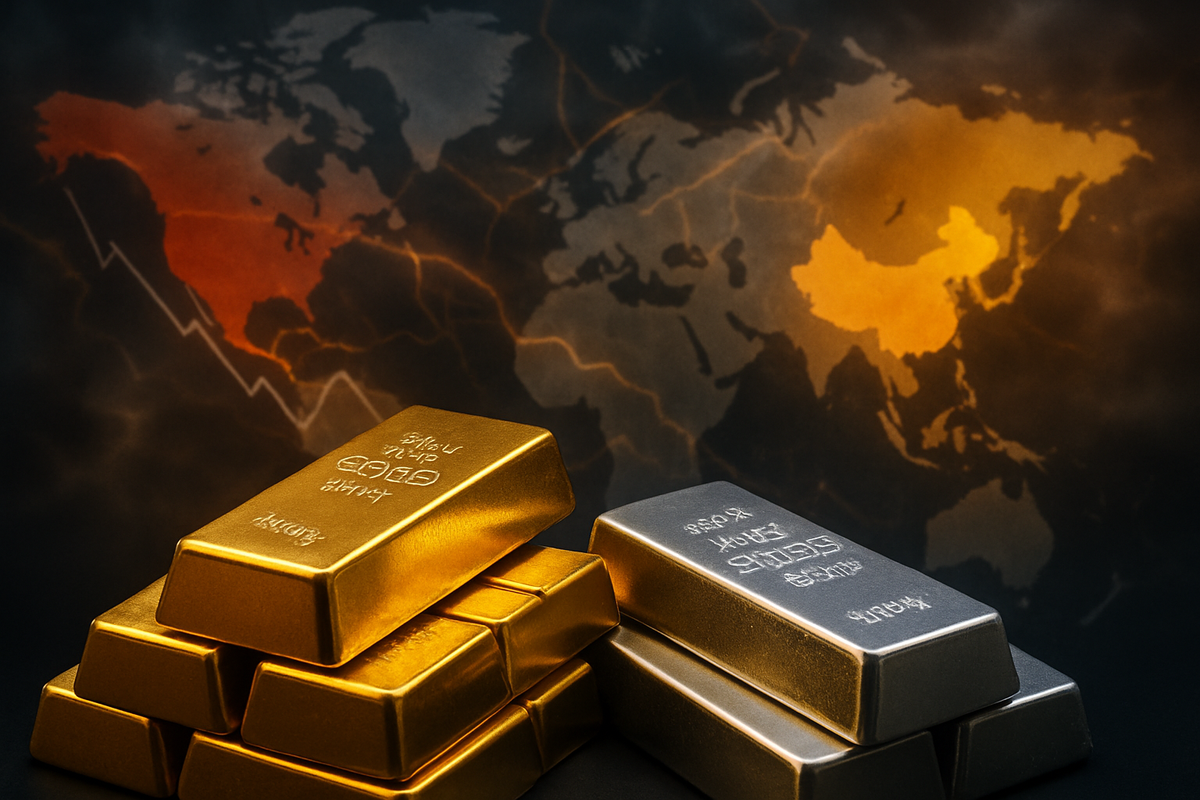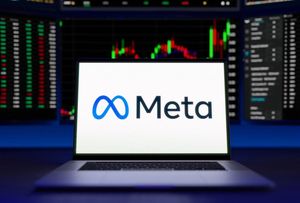
October 20, 2025 – In a financial landscape increasingly defined by volatility and uncertainty, gold and silver have surged to unprecedented levels, with both precious metals hitting record highs in October 2025. This remarkable rally is a direct consequence of escalating US-China trade tensions and a broader spectrum of geopolitical risks that are driving investors towards safe-haven assets. As traditional markets grapple with heightened instability, the enduring appeal of gold and silver as stores of value has never been more evident, underscoring a profound shift in investor sentiment towards security amidst global turmoil.
The current environment, marked by an intricate dance of diplomatic overtures and retaliatory measures between Washington and Beijing, coupled with persistent conflicts and political fragmentation worldwide, has created a powerful impetus for this flight to safety. The perceived stability and intrinsic value of these metals offer a crucial hedge against the potential erosion of wealth in more conventional investments, signaling a deeply entrenched apprehension about the future trajectory of the global economy and political order.
Geopolitical Storms Fueling Precious Metal Frenzy
The recent surge in gold and silver prices is inextricably linked to a series of specific geopolitical developments and economic anxieties that have unfolded in recent weeks. The US-China relationship, a perennial source of market concern, has once again taken center stage. On October 9, China escalated trade tensions by imposing new export controls on critical rare earth materials, production equipment, and lithium-ion batteries, alongside sanctions on US subsidiaries of a South Korean shipbuilding firm and new port fees for US vessels. These actions were widely interpreted as a direct response to expanded US trade blacklists targeting key Chinese industries. The very next day, October 10, President Trump responded with a threat of "massive" and "additional 100%" tariffs on all Chinese goods, slated to take effect on November 1, sending shockwaves through global markets.
However, a glimmer of de-escalation emerged by mid-October. President Trump publicly acknowledged that a 100% tariff on China would not be "sustainable," a statement that helped to calm some investor anxieties. This shift culminated in a significant announcement on October 20: an agreement to hold a new round of high-level trade negotiations in Malaysia "as soon as possible" between US Treasury Secretary Scott Bessent and Chinese Vice Premier He Lifeng. Despite this temporary reprieve, the underlying tensions persist, fueled by ongoing US restrictions on technology exports to China over intellectual property concerns and strategic competition for critical resources.
Beyond the US-China dynamic, a confluence of broader geopolitical risks is contributing to the global instability. The protracted Russia-Ukraine war and the Israel-Hamas conflict continue to fuel regional instability, raising concerns about energy and food security and contributing to elevated inflation rates globally. Domestic political turmoil in countries like France and Japan, coupled with fiscal uncertainties and political fragmentation across Europe, further contribute to an anxious investment climate. The ongoing US government shutdown is another significant domestic factor creating uncertainty. Investor anxiety has also been heightened by recent disclosures of loan irregularities linked to potential fraud in two US regional lenders, raising broader concerns about credit quality within the financial system. Moreover, a "tectonic shift" towards de-dollarization, with central banks actively diversifying their reserves away from the US dollar, provides structural support for precious metal prices. Climate change is also identified as a major geopolitical risk for 2025, with far-reaching impacts on global stability.
These events have directly translated into an unprecedented rally for precious metals. Gold prices have repeatedly hit record highs in October 2025, topping $4,300 per ounce. On October 17, gold reached an unprecedented $4,378.69 per ounce, solidifying its role as the "ultimate store of value." Silver has mirrored this surge, with its spot price hitting a new all-time high of $52 per ounce this week, marking a remarkable 60% rally since April and surpassing highs set in 1980. This robust performance is further bolstered by expectations for US Federal Reserve interest rate cuts, with markets pricing in a 99% chance of a 25 basis point cut at the Federal Open Market Committee (FOMC) meeting in late October, making non-yielding assets like gold and silver more attractive. Central bank activity, with institutions actively increasing their gold allocations, further underscores the institutional belief in the enduring value of these metals.
Companies Riding the Wave and Facing the Storm
The unprecedented rally in gold and silver prices, driven by geopolitical instability, creates a distinct set of winners and losers within the public market. Mining companies, particularly those focused on precious metals, stand to be significant beneficiaries. Major gold miners like Barrick Gold (NYSE: GOLD) and Newmont (NYSE: NEM) are experiencing a windfall as their primary product commands record prices. Higher gold and silver prices directly translate to increased revenue and potentially fatter profit margins, assuming their production costs remain relatively stable. These companies may see enhanced cash flows, allowing for greater investment in exploration and development, debt reduction, or increased shareholder returns through dividends and share buybacks. Smaller, junior mining companies with promising gold and silver deposits could also attract significant investor interest and capital, potentially leading to increased valuations and opportunities for growth.
Conversely, companies heavily reliant on stable international trade and global supply chains, especially those with significant exposure to US-China commerce, face considerable headwinds. Technology companies, automotive manufacturers, and consumer goods firms with complex supply chains that crisscross the Pacific could suffer from increased tariffs, export controls, and logistical disruptions. For instance, companies like Apple (NASDAQ: AAPL), which heavily relies on Chinese manufacturing and the Chinese consumer market, could see their profitability squeezed by tariffs and reduced demand in a strained economic environment. Similarly, semiconductor firms such as NVIDIA (NASDAQ: NVDA) or Qualcomm (QCOM), which are caught in the crossfire of technology export restrictions, may face challenges in accessing key markets or securing critical components.
Beyond direct trade impacts, the broader economic uncertainty fostered by geopolitical risks can dampen consumer spending and business investment, affecting a wide array of sectors. Retailers, hospitality companies, and discretionary spending industries may experience reduced demand. Financial institutions with significant exposure to international trade finance or with loan portfolios tied to vulnerable sectors could also face increased risks. Furthermore, the rising cost of commodities, while beneficial for miners, could increase input costs for manufacturers and certain industrial companies, potentially eroding their profit margins if they cannot pass these costs on to consumers. The shift of investor capital into safe havens also means less capital flowing into growth-oriented sectors, potentially impacting valuations for high-growth tech or innovative startups.
A New Era of Financial Hedging and Global Realignment
The current surge in gold and silver prices is not merely a fleeting market anomaly but rather a profound indicator of broader industry trends and a potential realignment of global financial strategies. This event fits squarely into a growing pattern of investors and central banks seeking tangible assets as a hedge against systemic risks. The escalating US-China trade tensions, coupled with persistent geopolitical flashpoints like the Russia-Ukraine and Israel-Hamas conflicts, highlight a world increasingly prone to sudden disruptions. This environment underscores the limitations of traditional fiat currencies and government bonds as sole safe havens, pushing a renewed focus on precious metals.
The ripple effects of this safe-haven demand extend across financial markets. As capital flows into gold and silver, it often diverts from other asset classes, potentially impacting equity markets, particularly those sensitive to economic growth and trade stability. For partners and competitors, the rising cost of capital and increased uncertainty could lead to strategic pivots. Companies with robust balance sheets and diversified operations may be better positioned to weather the storm, while those with high leverage or concentrated market exposure could face significant challenges. Furthermore, the trend of central banks diversifying their reserves away from the US dollar, which is accelerating with the de-dollarization movement, has significant regulatory and policy implications. It signals a potential shift towards a more multipolar global financial system, where the dominance of any single currency may diminish, prompting nations to re-evaluate their reserve management strategies.
Historically, periods of heightened geopolitical instability have consistently driven demand for precious metals. During the 2018-2019 US-China trade war, for instance, gold prices rose approximately 18.9%, demonstrating a clear precedent for the current market reaction. Looking further back, major global conflicts or economic crises, such as the 1970s oil shocks or the 2008 financial crisis, have seen gold and silver emerge as preferred safe havens. These historical comparisons reinforce the current narrative: in times of uncertainty, the intrinsic value and perceived stability of precious metals offer a powerful allure. The current environment, however, is unique in its confluence of trade wars, military conflicts, and an ongoing re-evaluation of global economic power structures, suggesting a more sustained and structural demand for these assets rather than a temporary spike.
Navigating the Shifting Sands: What Comes Next
Looking ahead, the trajectory of gold and silver prices will largely hinge on the evolution of US-China trade relations and the broader geopolitical landscape. In the short term, any significant de-escalation in trade tensions or progress in peace talks for ongoing conflicts could lead to profit-taking and temporary corrections in precious metal prices, as seen with gold's brief dip after President Trump's softened rhetoric. However, the underlying drivers – persistent inflation, robust central bank demand, and the pervasive geopolitical risks – are unlikely to dissipate quickly, suggesting that any pullbacks may be viewed as buying opportunities by long-term investors. The upcoming high-level trade negotiations in Malaysia will be a critical event to watch, as their outcome could either provide further stability or reignite tensions.
In the long term, the forces driving safe-haven demand appear more structural. The ongoing de-dollarization trend by central banks, coupled with continued global economic uncertainties and the potential for new geopolitical flashpoints, suggests a sustained demand for gold as a reserve asset. Silver, with its dual role as an investment metal and an industrial commodity (particularly in clean energy and semiconductor applications), stands to benefit from both safe-haven flows and growing industrial demand. Companies in the precious metals mining sector will need to adapt their strategic pivots to capitalize on these elevated prices, potentially by increasing exploration budgets, optimizing production, or consolidating assets.
Market opportunities may emerge for investors seeking to diversify their portfolios and hedge against inflation and geopolitical risk. Exchange-Traded Funds (ETFs) focused on gold and silver, as well as shares in well-managed mining companies, could offer avenues for participation. However, challenges include the inherent volatility of commodity markets and the potential for government intervention or policy changes that could impact supply or demand. Potential scenarios range from a continued, albeit volatile, ascent of precious metal prices if geopolitical risks persist and escalate, to more modest gains or even a correction if global stability significantly improves and central banks adopt a more hawkish stance on interest rates. Investors should closely monitor macroeconomic data, central bank communications, and geopolitical developments for clues about future price movements.
A Resilient Haven in Turbulent Times
The record-breaking surge in gold and silver prices in October 2025 serves as a stark reminder of the profound impact of geopolitical instability on financial markets. The escalating US-China trade tensions, compounded by a complex web of global conflicts and economic uncertainties, have undeniably cemented the role of precious metals as the ultimate safe haven. Key takeaways from this event include the direct correlation between geopolitical risk and safe-haven demand, the significant influence of central bank policies and de-dollarization trends, and the pronounced market reactions to both escalations and de-escalations in international relations.
Moving forward, the market for gold and silver is likely to remain robust, albeit with periods of volatility. While temporary reprieves in geopolitical tensions may trigger short-term profit-taking, the underlying structural demand driven by persistent global risks and a shifting financial landscape is expected to provide continued support for these assets. Investors should approach this environment with a strategic mindset, recognizing the long-term hedging capabilities of precious metals against inflation and systemic risk.
The lasting impact of this period will likely be a reinforced understanding of gold and silver's critical role in diversified portfolios, particularly in an era characterized by geopolitical fragmentation and economic uncertainty. What investors should watch for in the coming months includes the progress of US-China trade negotiations, any new developments in ongoing global conflicts, the stance of major central banks on interest rates, and further indications of central bank gold purchasing activity. These factors will be crucial in shaping the continued narrative of precious metals as resilient havens in turbulent times.
This content is intended for informational purposes only and is not financial advice






